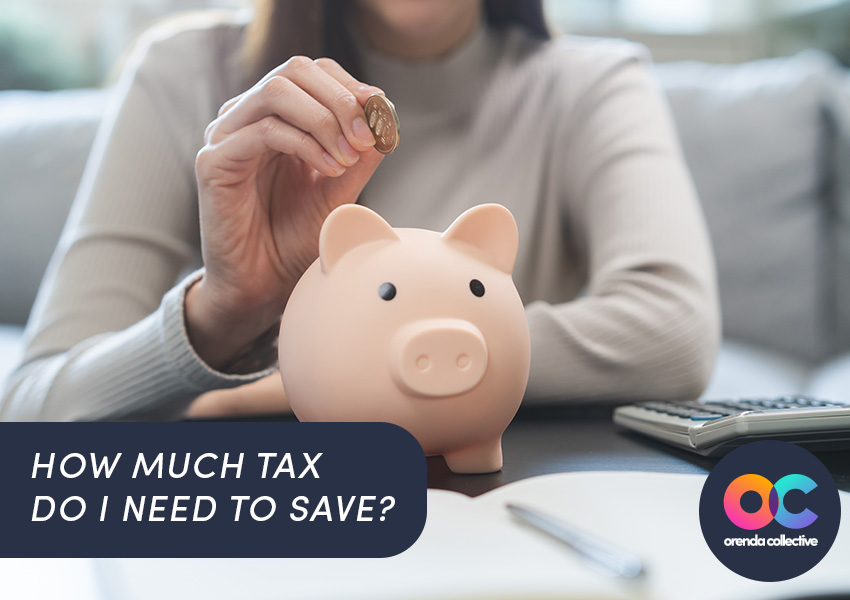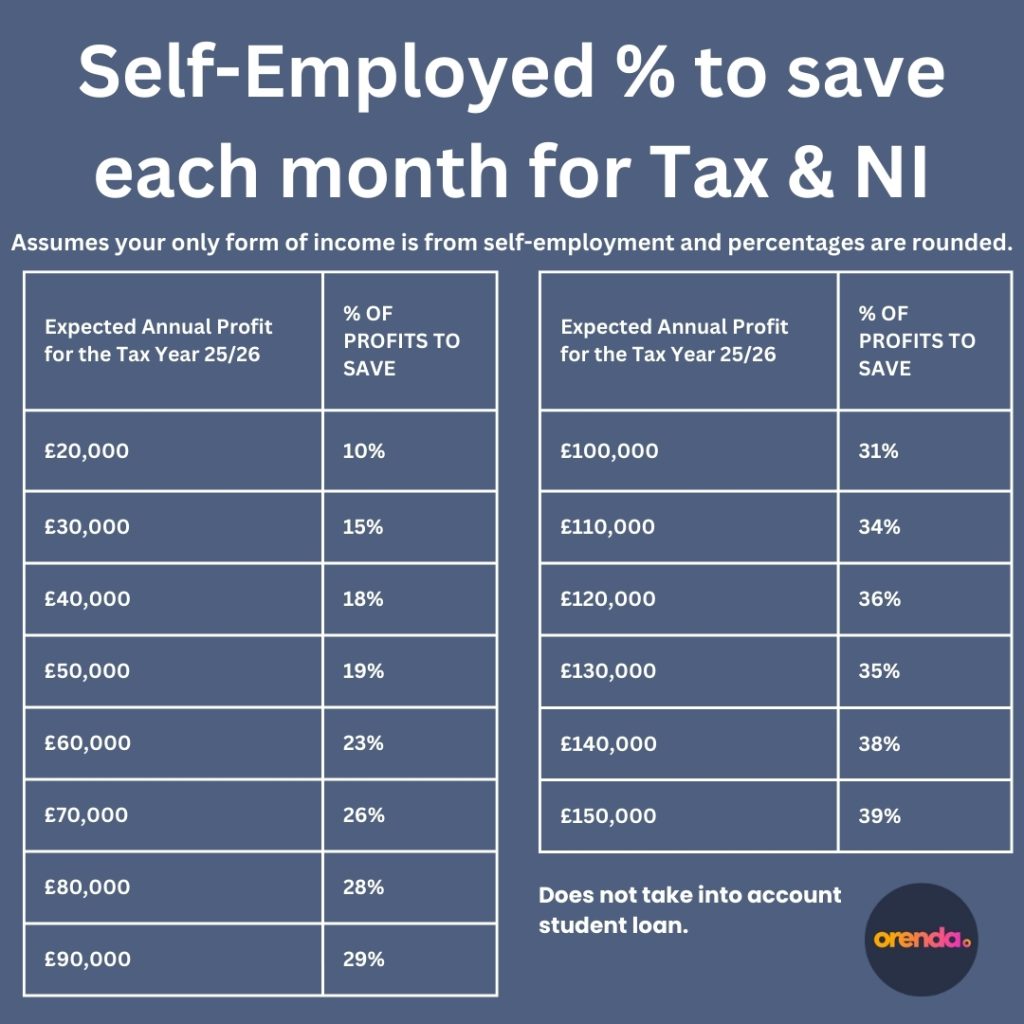
If you’re self-employed or run a small business, one of the biggest financial worries can be setting aside enough for your tax bill. No one wants a nasty surprise when the payment deadline rolls around!
So, how much should you actually save? In this guide, we’ll break it down step by step to help you plan ahead with confidence.
Why Do You Need to Save for Tax?
Unlike employees, who have tax deducted automatically through PAYE, self-employed individuals must calculate and pay their own tax and National Insurance Contributions (NICs).
HMRC expects you to make two tax payments each year:
- Self Assessment Tax Bill (due by 31st January following the end of the tax year)
- Payments on Account (advance payments towards next year’s tax bill, due 31st January and 31st July)
To avoid any last-minute panic, it’s important to save as you go.
How Much Should You Set Aside?
The exact amount depends on your taxable profit (income minus allowable expenses). Here’s a simple way to estimate how much to save:
Step 1 – Estimate your taxable profit for the year
- Add up all your expected business income.
- Subtract allowable expenses (e.g., rent, travel, equipment).
Once you have this figure, you can calculate how much tax and NICs you’ll owe.
TIP: If you use Xero, you can run the profit and loss report to show you for profit for the period.
Step 2 – Determine your tax band based on your taxable profit estimate
There are different rates depending on which tax band you fall in, so it is key that you get this bit right.
Where you see the * within the higher rate threshold it is really important to highlight that when your taxable profits are between £100,000 and £125,140 you start to lose your tax free allowance. For every £2 that your profits are are over £100,000 you lose £1 of your tax free allowance. This means that when your profits are £125,140 or more you receive no tax free allowance at all, effectively making the tax you pay on amounts earned between £100,000 and £125,140 60% – we refer to this as the tax trap. If your profits are in excess of £100,000 we strongly recommend you get in contact with us to discuss ways of avoiding the tax trap and how to accurately estimate your tax bill.
| Estimated Profit | Tax band | Rate |
| £0 and £12,570 | Tax free allowance | 0% |
| £12,570 and £50,270 | Basic rate tax | 20% |
| £50,270 and £125,140 | Higher rate tax * | 40% |
| £125,141 + | Additional Rate |
45% |
Step 3 – Calculate your income tax estimate
Now you think it would be easy to work out your tax, right? Multiply your profit by the rates above, but there is a little bit more to it. Don’t worry though, we have given examples below to break it down for you.
Your profit falls between £12,570 and £50,270
In this example the profit is £35,000, but you can follow the same steps substituting your profit figure in. To estimate your tax, follow these steps:
- Profit (£35,000) – personal allowance (12,570) = £22,430
- £22,340 x 20% = £4,486
- Total tax to pay £4,486
Your profit falls between £50,270 and £100,000
In this example the profit is £75,000, but you can follow the same steps substituting your profit figure in. To estimate your tax, follow these steps:
- Profit (£75,000) – basic rate band (£50,270) = £24,730
- £24,730 x 40% = £9,892
- £50,270 – personal allowance (£12,570) = £37,700
- £37,700 x 20% = £7,540
- Total tax to pay = £9,892 + £7,540 = £17,432
Step 4 – Calculate your national insurance estimate
Self-employed individuals pay Class 2 and Class 4 national insurance (“NI”).
Class 2 NI
If your profit is above £6,725 you do not need to pay class 2 NI contributions, it is deemed as having been paid.
If your profits are less than £6,725 you can chose to voluntarily pay class 2 NI of £3.50 per week or £182 per year (2025/26), you may chose to do this to ensure you are entitled to benefits such as state pension.
Class 4 NI
| Profit | NI rate |
| Up to £12,570 | NIL |
| £12,570 and £50,270 | 6% |
| Over £50,270 | 2% |
So, using the same examples as above:
Your profit falls between £12,570 and £50,270
In this example the profit is £35,000, but you can follow the same steps substituting your profit figure in. To estimate your NI, follow these steps:
Class 2 NI
NIL as your profit is in excess of £6,725.
Class 4 NI
- Profit (£35,000) – NI lower profits limit (£12,570) = £22,430
- £22,430 x 6% = £1,345.80
- You will pay £1,345.80 of class 4 NI
Your profit falls between £50,270 and £100,000
In this example the profit is £75,000, but you can follow the same steps substituting your profit figure in. To estimate your NI, follow these steps:
Class 2 NI
NIL as your profit is in excess of £6,725.
Class 4 NI
- £75,000 – NI upper profits limit (£50,270) = £24,730
- £24,730 x 2% = £494.60
- NI upper profits limit (£50,270) – NI lower profits limit (£12,570) = £37,700
- £37,700 x 6% = £2,262
- £2,262 + £494.60 = £2,756.60
- You will pay £2,756.60 of class 4 NI
Step 5 – Total tax bill estimate
The last thing you want to do is add your tax, class 2 NI and class 4 NI estimates together, to arrive at your total expected tax bill.
Example for £35,000 of self-employed profits
Tax = £4,486
Class 2 NI = £NIL
Class 4 NI = £1,345.80
Total = £5,831.80
Example for £75,000 of self-employed profits
Tax = £17,432
Class 2 NI = £NIL
Class 4 NI = £2,756.60
Total = £20,188.60
How much tax to save as a percentage based on different profit levels
If you found the above a little too complicated and just want a set percentage to put aside on all your profits we’ve created a table for the 2025/26 tax year so you can get started straight away. Please note, if you are between profit thresholds its always best to save based on the higher percentage to be safe.
Best Practices for Tax Saving
- Have a different bank account for your self-employed business to keep personal and business transactions separate – this one is really game changing when it comes to preparing your tax return.
- Open a separate savings account just for tax – or if your bank offers ‘pots’ or ‘spaces’ utilise these to keep money you can spend and money you are saving for tax apart.
- Save a percentage of every payment you receive to avoid under saving – you can automate this on banks such as Monzo. If you are saving as a percentage of sales as opposed to profit the actual percentage will be less than those quoted above, but to be prudent it never hurts to save more.
- Use accounting software like Xero to track earnings and tax estimates.
Don’t Forget VAT
If your business turnover exceeds £90,000 in a 12 month rolling period, you must register for VAT. This means you may need to set aside an additional amount to cover VAT liabilities. To understand more about VAT read our guide here.
Need Help with Your Tax Planning?
Estimating and saving for tax can feel overwhelming, but you don’t have to do it alone. At Orenda Collective, we help freelancers and business owners take control of their finances with clarity and confidence.
💡 Need tailored advice? Get in touch today!
Points of note:
Disclaimer:
The information in this blog is for general guidance only and does not constitute accounting, tax, or business advice. Every business is unique, and we recommend seeking personalised advice before making any financial or strategic decisions. If you need tailored support, feel free to contact us.
- This is for tax year 2025/2026 and only applies to those with ONLY self-employed income, if you have other forms of income get in touch and we will be happy to help.
- The above method is not a substitute for using an accountant to file your year end tax return to HMRC. This is because there are multiple factors that will impact your final taxable profit for submission to HMRC.
- The above methods do not work if you earn over £100,000 as you begin to lose your personal allowance, but we don’t want to over complicate the examples. Feel free to reach out to us if you need help here.

